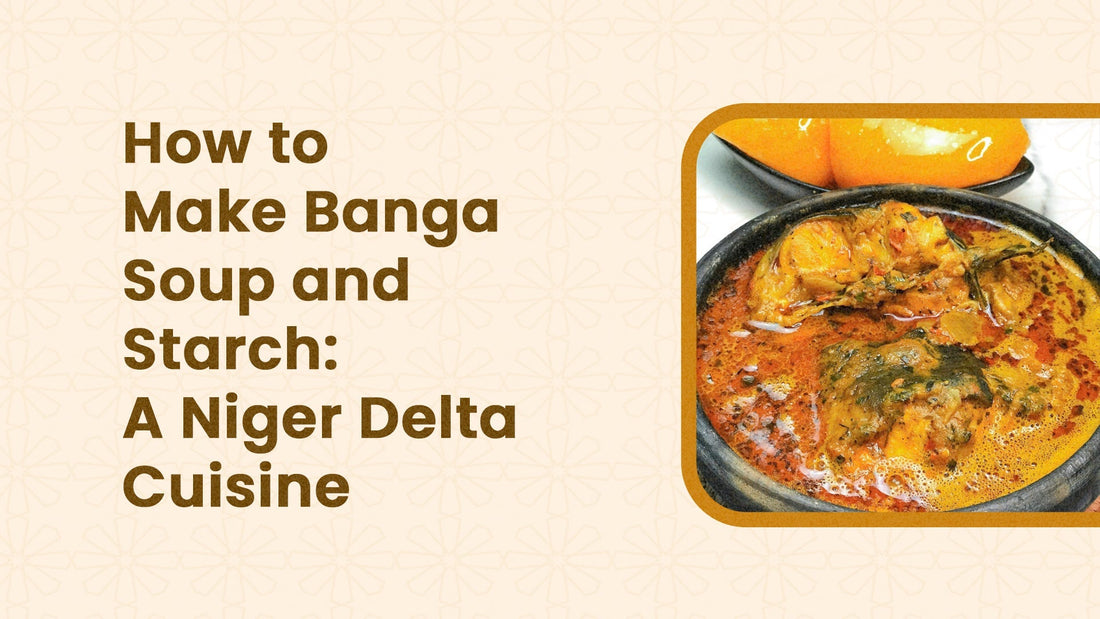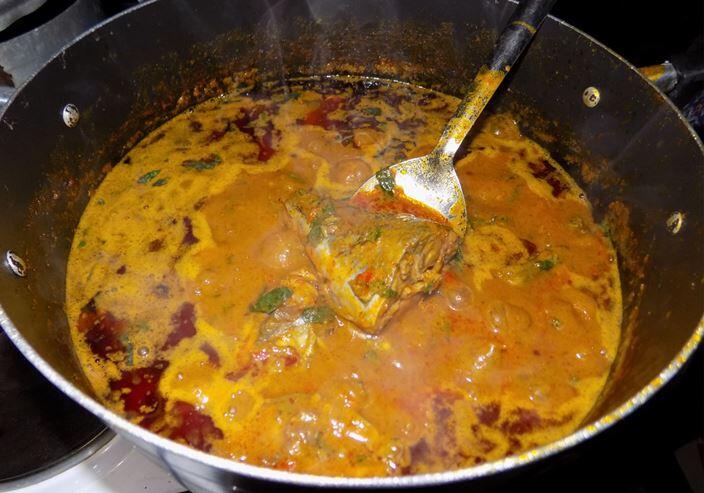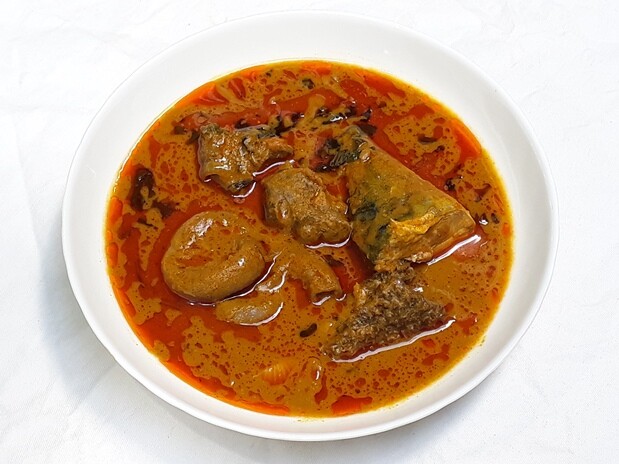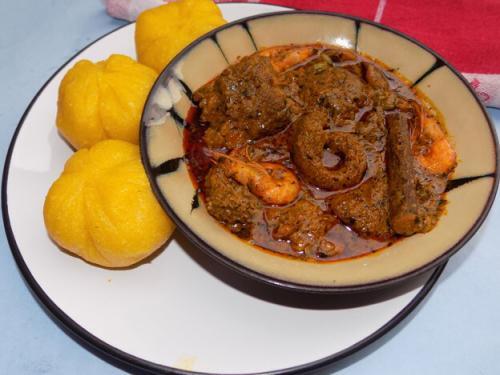
How to Make Banga Soup and Starch: A Niger Delta Cuisine
Share
There's a particular kind of hunger that only Banga soup can satisfy. Not the ordinary kind that makes your stomach growl, but the soul-deep longing for home, for tradition, for the taste of the Niger Delta captured in a pot. If you've ever watched your grandmother stand over a simmering pot of palm fruit extract, stirring with the confidence of someone who's made this soup a thousand times, you know exactly what I mean.

Image from: The Thelma Kitchen
Banga soup—also known as Ofe Akwu among the Igbo—is more than just a dish. It's the taste of riverside communities, of palm trees swaying in tropical breezes, of kitchens where recipes weren't written down because they lived in the hands and hearts of the women who made them. And when paired with starch, that stretchy, slightly sour, gloriously unique swallow, you have a combination that defines an entire culinary tradition.
The Story Behind Banga Soup
Long before celebrity chefs and food bloggers, before anyone thought to call Nigerian cuisine "trendy," there was Banga soup. In the creeks and waterways of the Niger Delta—Rivers State, Bayelsa, Delta State—women harvested palm fruits, boiled them until they were soft enough to extract their essence, and created something that would sustain their families for generations.
This wasn't convenience food. This was survival, celebration, and culture all rolled into one pot. Every wedding had Banga soup. Every burial. Every Sunday after church. Every time someone came home from a long journey. The soup was there, constant and comforting, a red-gold thread connecting past to present.

Image from: All Nigerian Foods
Understanding Banga Soup: What Makes It Special
The Soul of the Soup: Palm Fruit Extract
At the heart of Banga soup lies palm fruit extract—not palm oil, but the actual liquid drawn from boiled palm fruits. This is what gives the soup its distinctive flavor, its thick, unctuous texture, its deep orange-red color that looks like liquid sunset. The extract carries all the complexity of the palm fruit: earthy, slightly sweet, with a richness that coats your mouth and makes you reach for another mouthful before you've finished the first.

Getting authentic palm fruit extract used to mean hours of work—boiling fresh palm fruits, pounding them, and extracting the liquid through a strainer. Today, L'Afrique Market brings you the same authentic flavor in convenient form with their Banga Soup Mix, capturing all that traditional richness without the hours of labor.
The Spice Symphony: Banga Spices
What separates good Banga soup from unforgettable Banga soup is the spice blend. Traditional Niger Delta cooks use a combination called "banga spices"—a mixture that might include:
- Ehuru (African nutmeg): Warm, slightly sweet, with a complexity that European nutmeg can't match
- Uda (Negro pepper): Aromatic, slightly bitter, with a smokiness that anchors the soup
- Oburunbebe sticks: The secret ingredient that gives authentic Banga soup its characteristic slightly bitter undertone and authentic aroma
- Dried catfish: Ground into the spice mix for depth
- Crayfish: For that essential umami punch
The Banga Spice blend from L'Afrique Market contains this traditional combination, carefully balanced so you don't have to hunt down individual ingredients across multiple stores. It's the wisdom of Delta grandmothers, packaged for your modern kitchen.
Essential Ingredients for Authentic Banga Soup
Before we dive into the method, let's talk about what you need. This isn't a soup where substitutions work well. The ingredients matter because they each play a specific role in the final symphony of flavors.
Core Ingredients:

Image from: Facebook
For the Soup:
- 2 cups Banga soup mix (palm fruit extract) - Get authentic Banga mix from L'Afrique Market
- 2-3 tablespoons Banga spice blend - Find traditional Banga spices here
- 1 pound assorted meat (beef, goat meat, or bush meat)
- 1/2 pound fresh fish (catfish or tilapia)
- 1/4 cup dried fish (deboned and soaked)
- 1/4 cup stockfish (pre-soaked until soft)
- 2 tablespoons ground crayfish
- Fresh scent leaves (2-3 leaves, shredded) or bitter leaf
- Salt to taste
- 2-3 scotch bonnet peppers (or to taste)
- 1 medium onion (chopped)
For the Starch:
- 2 cups garri (white garri works best)
- 4-5 cups water
- Pinch of salt
The Art of Making Banga Soup: Step by Step
Preparation: Setting the Stage (20 minutes)
The key to great Banga soup is in the preparation. This isn't a dish you rush.
- Prepare your proteins: Wash the assorted meat thoroughly. Cut into bite-sized pieces. Season with salt, a bit of ground crayfish, and chopped onions. Let it marinate while you prepare everything else.
- Soak dried ingredients: Your dried fish and stockfish should be soaked in warm water for at least 15 minutes. The stockfish especially needs this—you want it soft enough to eat but firm enough to hold its shape.
- Clean your fresh fish: If you're using catfish, clean it thoroughly (or have your fishmonger do it). Cut into steaks. Tilapia should be descaled, cleaned, and cut into pieces.
- Prepare your vegetables: Wash and shred your scent leaves or bitter leaf. If using bitter leaf, squeeze and wash repeatedly to reduce bitterness. Set aside.
Cooking: Building Flavor Layers (45-60 minutes)
Here's where the magic happens. Banga soup is about layering flavors, allowing each component to contribute to the whole.
Step 1: Cook the Meat (20 minutes)

Image from: Pinterest
In a large pot, add your seasoned meat with just enough water to cover it. Bring to a boil, then reduce to a simmer. Cook until the meat is tender. This isn't just about cooking the meat—you're creating the stock that will form the base of your soup.
Step 2: Introduce the Banga (10 minutes)

Once your meat is tender, it's time for the star ingredient. Pour in your Banga soup mix from L'Afrique Market. Stir it into the meat stock. Bring it to a gentle boil, then reduce the heat to medium-low.
Here's what's happening: The palm fruit extract is releasing its oils, its flavors are melding with the meat stock, and the distinctive Banga aroma is beginning to fill your kitchen. If you're doing this right, anyone walking past your home will stop and wonder what miracle is happening in your kitchen.
Step 3: Add the Banga Spices (5 minutes)
This is the moment of transformation. Add your Banga spice blend from L'Afrique Market. Start with 2 tablespoons, stir well, and let it cook for a few minutes. Taste. The soup should have a complex, slightly bitter, deeply savory flavor. If you want more depth, add another tablespoon of the spice mix.

The oburunbebe sticks in the spice blend are releasing their essence, the ehuru is adding warmth, the uda is contributing its smoky bitterness. This is why authentic spice blends matter—each element is calibrated to create something larger than the sum of its parts.
Step 4: Layer in the Seafood (15 minutes)
Now add your dried fish and stockfish. These need time to absorb the soup's flavors and release their own. Let them simmer for about 10 minutes.

Image from: Facebook
Next, add your fresh fish. This is delicate—you don't want it to break apart completely. Lower the fish pieces gently into the soup. Add your ground crayfish now too. Let everything simmer together for another 5-7 minutes.
Step 5: Final Touches (5 minutes)
Add your shredded scent leaves or bitter leaf. Add your whole scotch bonnet peppers (don't break them unless you want serious heat). Taste and adjust the salt.
Let the soup simmer for another 5 minutes. Then remove it from heat and let it rest. This resting period is crucial—it allows all the flavors to marry, to become a unified whole rather than separate components.

Image from: All Nigerian Foods
Making the Perfect Starch: The Ideal Companion
While your Banga soup rests, let's make starch. If you've never made it before, you're in for a treat. Starch is unlike any other Nigerian swallow—it's stretchy, slightly sour, with a texture that's perfect for scooping up Banga soup.
The Starch Process (15 minutes)
Step 1: Create the Base
Boil 4 cups of water in a pot. Add a pinch of salt. In a separate bowl, mix your garri with about 1 cup of cold water. Stir until you have a smooth, lump-free mixture.
Step 2: The Transformation
Here's where it gets interesting. Pour your garri mixture into the boiling water. Stir immediately and vigorously. You'll notice something magical happening—the mixture begins to thicken, to become glossy, to develop that characteristic stretchy quality.
Keep stirring. The starch should be smooth, stretchable, and glossy. If it's too thick, add a little hot water. If it's too thin, mix a bit more garri with cold water and add it in.
Step 3: The Test
Starch is ready when it's smooth, stretchy, and doesn't stick to your stirring spoon. It should have a slight sheen, a consistency that's softer than eba but firmer than fufu.
The Moment of Truth: Bringing It All Together
Now comes the best part. Serve your Banga soup in a deep bowl. The soup should be thick enough to coat a spoon but liquid enough to flow. The color should be a rich orange-red, with visible pieces of fish and meat. The aroma should be complex—earthy, smoky, slightly bitter, deeply savory.

Image from: All Nigerian Foods
Mold your starch into a ball or serve it in a separate bowl. Take a piece of the starch, stretch it (yes, stretch it—this is part of the joy), dip it into the soup, and eat.
The combination is extraordinary. The slightly sour starch cuts through the richness of the soup. The stretchy texture plays against the thick, unctuous soup base. The mild flavor of the starch allows the complex Banga flavors to shine. Every mouthful is a balance of textures and temperatures and tastes.
Pro Tips from Delta Grandmothers
Tip 1: Low and Slow
Banga soup shouldn't be rushed. The longer it simmers (within reason), the more the flavors develop. Some cooks let it simmer for over an hour, adding water as needed to maintain consistency.
Tip 2: The Fish Matters
Fresh catfish is traditional for a reason—its firm texture holds up to the long cooking time, and its slight earthiness complements the palm fruit extract. Tilapia works too, but add it toward the very end to prevent it from completely breaking apart.
Tip 3: Don't Skip the Stockfish
Dried stockfish adds a depth of flavor that fresh fish alone can't achieve. Yes, it requires soaking and preparation, but the result is worth it. L'Afrique Market carries quality stockfish that's already been properly processed—you just need to soak it.
Tip 4: The Oburunbebe Difference
If your soup doesn't taste quite right, it's probably missing oburunbebe. This traditional ingredient is what gives Banga soup its authentic character. That's why using a proper Banga spice blend from L'Afrique Market matters—it contains this crucial element.
Tip 5: Starch Consistency
The perfect starch should stretch when you pull it. If it doesn't, you've added too much garri or not stirred enough. Don't be afraid to add water and keep stirring until you get that characteristic stretchiness.
Regional Variations: Delta vs. Rivers vs. Bayelsa
While the foundation remains the same, different Niger Delta communities have their own touches:
Delta State Version:
- Often includes periwinkles (small sea snails)
- May add bitter leaf in addition to scent leaves
- Sometimes includes garden egg
Rivers State Version:
- Tends to use more dried fish
- Often includes fresh prawns or crayfish
- May add a bit of palm oil for extra richness
Bayelsa State Version:
- Often features bush meat when available
- May include more herbs and scent leaves
- Sometimes uses a combination of stockfish varieties
The beauty is that all versions are "correct." Each family, each cook brings their own wisdom to the pot.
The Health Benefits Hidden in Every Bowl
Beyond the incredible taste, Banga soup offers serious nutritional value:
Palm Fruit Extract:
- Rich in vitamin A and E
- Contains antioxidants
- Provides healthy fats
- Supports eye health and immune function
Fish and Stockfish:
- Excellent protein source
- Provides omega-3 fatty acids
- Rich in minerals like calcium and phosphorus
- Low in unhealthy fats
Traditional Spices:
- Ehuru supports digestive health
- Uda has antimicrobial properties
- Scent leaves provide essential vitamins
- Bitter leaf supports liver function
This isn't just comfort food—it's functional food, the kind that sustained communities for generations because it nourished both body and soul.
Common Mistakes and How to Avoid Them
Mistake 1: Using Palm Oil Instead of Palm Fruit Extract
Palm oil and palm fruit extract are not the same. Palm oil will make your soup greasy and won't provide the distinctive Banga flavor. Always use proper Banga soup mix—the authentic blend from L'Afrique Market ensures you're using the real thing.
Mistake 2: Skipping the Spice Blend
Some people try to make Banga soup with just palm fruit extract and basic seasoning. The result is flat and one-dimensional. The traditional spice blend is what creates complexity. Don't skip it.
Mistake 3: Overcooking the Fresh Fish
Fresh fish should be added toward the end and cooked just until done. Overcooked fish breaks apart completely and disappears into the soup.
Mistake 4: Making Starch Too Thick
Starch should be softer than eba. If it's too thick, it won't have that characteristic stretch and will be difficult to swallow.
Mistake 5: Not Tasting as You Go
Every ingredient varies slightly—your fish might be saltier, your Banga mix might be richer, your spice blend might be more intense. Taste frequently and adjust.
Pairing Suggestions: What to Serve Alongside
While Banga soup and starch is a complete meal on its own, consider these additions:
Cold Beverages:
Side Dishes:
- Fried plantains (the sweetness contrasts beautifully with the soup)
- Garden egg and pepper sauce
- Fresh vegetable salad
- Steamed vegetables
Protein Additions:
- Snails (a traditional favorite)
- Fresh prawns (added at the end)
- Periwinkles (for coastal authenticity)
- Bush meat (if available)
Storing and Reheating: Making It Last
Storage:
Banga soup stores well in the refrigerator for up to 4 days and can be frozen for up to 2 months. Store in airtight containers as the flavors actually improve after a day, as they continue to meld.
Reheating:
Reheat gently on the stovetop. Add a splash of water if the soup has thickened too much. Don't microwave if you can avoid it—stovetop reheating preserves the texture better .Taste and adjust seasoning after reheating
Starch:
Starch doesn't store well—it's best made fresh. If you must store it, keep it in an airtight container for no more than 24 hours. Reheat gently with a bit of water, stirring to restore the stretchy texture
Why L'Afrique Market Makes the Difference
Here's the truth about cooking authentic Nigerian food: ingredients matter. You can follow the recipe perfectly, but if your Banga mix isn't authentic, if your spice blend is missing key components, if your stockfish is poor quality, the result will always fall short.
This is where L'Afrique Market becomes essential. They don't just sell ingredients—they curate authenticity. Their Banga soup mix is sourced to match what you'd get if you processed fresh palm fruits yourself. Their spice blends contain the traditional components, properly balanced, so you don't have to hunt through ten different stores for ehuru, uda, and oburunbebe.
When you cook with ingredients from L'Afrique Market, you're cooking with the same quality that Delta grandmothers insist on. You're ensuring that when you serve your Banga soup, it tastes like it's supposed to—like home, like tradition, like the Niger Delta captured in a pot.
Conclusion: More Than Just a Meal
Banga soup and starch isn't just food—it's a connection to the Niger Delta, to the communities that developed this dish over generations, to the wisdom of cooks who understood how to transform simple ingredients into something extraordinary.
Every time you make this soup, you're participating in a tradition that stretches back centuries. You're honoring the women who stood over pots, stirring, tasting, adjusting until it was perfect. You're keeping alive flavors that might otherwise be lost in a world of fast food and shortcuts.
But you can only do this with authentic ingredients. The Banga mix matters. The spice blend matters. The quality of your stockfish and dried fish matters. These aren't details—they're the difference between a meal that tastes vaguely like Banga soup and a meal that transports you to the creeks of the Niger Delta, that makes you close your eyes and smile, that tastes exactly like memory.
L'Afrique Market understands this. They know that when you search for Banga soup mix, you're not just looking for an ingredient—you're looking for a connection to home, to tradition, to the authentic taste of Nigerian cuisine.
So go ahead. Order your Banga soup mix, your spice blend, your stockfish from L'Afrique Market. Set aside an afternoon. Turn off your phone. Stand over that pot and stir, taste, adjust. Let the aroma fill your kitchen. Make the soup the way it's supposed to be made.
Then sit down with a bowl of Banga soup and perfectly stretched starch, and taste home. That's what authentic ingredients give you—not just a meal, but a homecoming, one delicious mouthful at a time.
